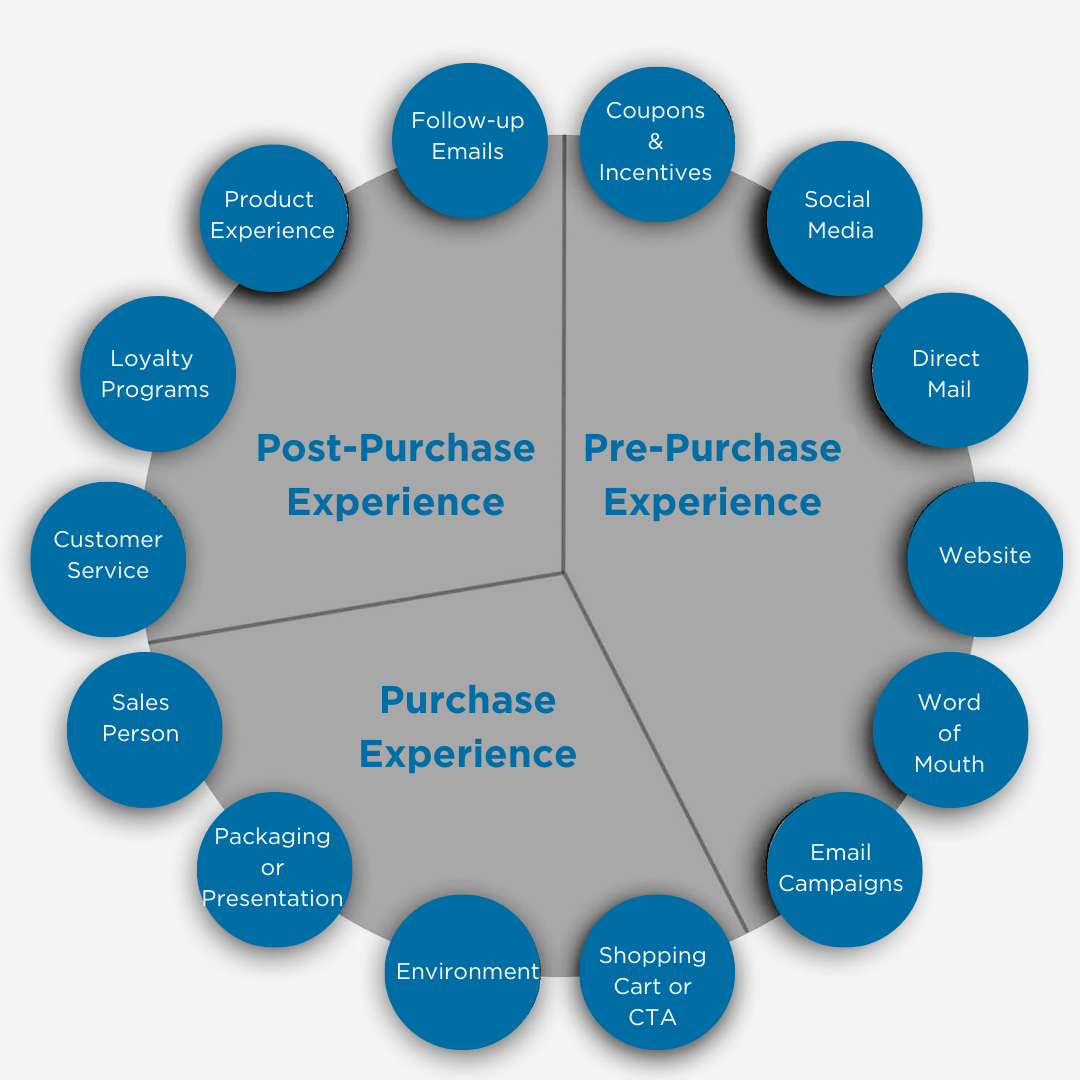Put Your Money Where Your Mailing List Is
I grew up in Minnesota, and I like to think time spent in a place that is beautiful and bitter made me more resourceful and resilient, qualities that have certainly come in handy in 48 years of business. Those qualities, as well as persistence, are also valuable as you create a direct mail strategy to turn prospects into loyal customers. And it all starts with your mailing list.
Persistence and repetition are key
It takes at least five tries, or eight to twelve depending on whom you ask, to get a prospective customer to talk to you.
We’ve all had our feet pushed out the door by potential customers. They don’t know us, they are busy, and they guard their time like a Rottweiler. We not only feel rejected but like we are wasting massive amounts of time.
In such situations, persistence is essential. Tim Wackel, a sales training expert, has found that we must approach potential customers at least five times before they’ll give us some time; nearly 80% of new business sales happen on or after the fifth contact. Most of us, according to Wackel, give up after two or three tries.
If you’re wondering how, you could possibly reach a potential customer that many times, check out the graphic below. It doesn’t mean calling them day after day. It means getting your name in front of them in a memorable way, multiple times. And don’t stop after the purchase has been completed if you expect to keep them as a customer.
Direct mail can introduce your company to prospective clients
One of the best ways to break down barriers is through a direct mail campaign. Direct mail can introduce your company to potential clients, educate them about your products or services and show them how your company helps its customers.
And in case you are about to argue that direct mail is dead, studies show the average return on investment (ROI) is $4.09 for every $1.27 spent. And according to Small Biz Genius, not only do 42.2% of recipients read or at least scan the direct mail received, 73% of people prefer direct mail because they can read it on their own time.
Build your own list of prospective customers
Companies often dive head-first into direct mail. They buy an enormous mailing list and start peppering those on the list with weekly postcards.
Using direct mail effectively requires more of a deep dive than a big splash. The success of these campaigns’ rests almost entirely on the quality—not the quantity—of the prospects on your mailing list. Instead of buying a list from a list broker, I suggest you build your own or have one built to your specifications.
Making your own prospect list allows you to start a targeted direct mail campaign and forces you to think more strategically about whose business you want to pursue. You can’t do business with everyone, which is why it makes sense to hand-pick your prospects, using the customers you value as models for what you look for in future clients. It prevents you from wasting time and money chasing a business that is not a good fit.
Identify the qualities of your ideal customer.
What does your ideal client or customer look like? Is the customer a man or a woman? Young or old? Rich or poor? Where do they live? What do they do for a living? Why do they want or need your product or service? How often do they buy it?
Granted, we all realize that our customers aren’t all the same, but I guarantee that yours have commonalities. If you run a B2B company, make a list of your top 5 to 10 current customers. You can measure your “ideal customer” in various ways: annual sales, number of employees, rate of expansion and growth, and geographic location. After you compile a list, think about what qualities these customers share. What traits do you appreciate?
In addition to looking at qualities you’d like to see in a client, think about things that would make you kick a client off your list.
Here are a few:
- Bad reputation (dishonest business dealings, questionable finances, employment problems)
- Legal issues
- Unpleasant to work with
- Disorganized and unprofessional
Growing your business, the best way
By merging your targeted prospect list with a direct mail campaign, you target customers that are best for your business. As you build your list, here are other points to consider in choosing your prospects:
Whom do I want to build a relationship with over time?
Anyone who has owned a business will tell you that not all customers are created equal. In fact, some customers, because of the time they require, the irritation they cause, and the demands they make, are not worth having from a cost/benefit standpoint. The best customers work well with you, like your product or service, have few complaints or are effective complainers, and pay you on time and without hassle.
Pick business niches or verticals that you understand.
Who can you talk most directly to? You don’t want to put all your chickens in one henhouse, but your business becomes more effective and efficient when you specialize in a few areas. One area of specialty for our business is creating and managing invoices for utility companies. When you operate within a niche like that, you learn the lingo and the pain points. When it is obvious that you understand a customer’s business, they are more likely to choose you as a supplier.
Avoid competing or overlapping businesses.
Gas and electric companies generally serve geographic areas where they are the sole source for energy, so they rarely have competitors. But if, for example, your potential clients are hospitals, you must take care to avoid those that compete with one another for patients.
Estimate a potential customer’s value.
Weigh the cost of doing business with clients versus the revenues that could be generated by providing them with a product or service. Does the potential revenue exceed the cost? Factor in the time it will take to meet with the client on an ongoing basis. How many of your employees will spend time on this account? It’s important to know the total revenue you can realistically expect from a single customer account for the entirety of the business relationship. Here’s a tool you can use for calculating a customer’s lifetime value (LTV).
Build a targeted mailing list in 3 steps
There are two routes to building mailing lists. You can buy existing lists based on what you want in a client. While that is better than simply mailing haphazardly, building your own list is best because you will end up with customers that are a better fit for your company.
Remember, creating these lists is part science and part art. Be flexible and creative; you and your staff will come up with ideas and methods beyond these that work well for your business.
1. Set a reasonable goal
If you have a team that can dedicate time to the project, start with a big goal. Find someone in your company who doesn’t mind doing some detective work: building a list requires phone calls and digging through websites and other online sources.
For modest businesses, I recommend starting small, so the task isn’t overwhelming. Perhaps compile data on 200 potential customers. If that sounds like too many, go for 100. But start somewhere. Do what you can do and gradually build on it.
2. Have staff add their ideal prospects to the list
Using the qualities of an “ideal” customer that you came up with, create a list of prospective clients. Names can come from several sources. Make sure everyone involved in sales and marketing in your company contributes to the list.
Names can come from:
- Contacts made on LinkedIn
- Contacts made at trade shows, conferences, and meetings
- Industry and business directories
- Companies on your sales peoples target list
- Members of professional associations
- Media reports (stories about companies read in newspapers, magazines, and online)
3. Do research online and on phone to complete a client information form
After your list has been compiled, choose a client information form (make sure the style you choose has room for notes) and have your staff person begin to add the required data — phone numbers, email addresses, contact information, key contacts within the organization. This will take multiple phone calls and Google searches. Use phone calls to double-check key contacts and other information, which can quickly become outdated. Make any updates in the client information form (Also, remember that you will need to update this form at least once a year, more often if possible.)
We built our own mailing list, identifying 11 business areas where Bluegrass had expertise, existing customers, and potential for growth. We then used various resources to find prospects in those categories. We narrowed the list using geographic and financial parameters.
Your staff can use websites to gather a lot of information, but often a follow-up phone call is a wise way to double-check the names of the best contacts and their job titles.
Six steps to planning and executing your direct mail campaign
With your targeted prospect list in hand, you can go forward with your direct mail campaign. Here are the steps.
Choose a calendar and use it to plan your annual direct mail campaign.
I don’t recommend a particular calendar, but I will point out that because a direct marketing campaign will involve a team of sales, management, and marketing staff, it makes sense to use a format that can be shared. An online calendar is great, but you could also tack large monthly calendars on your conference room wall to create a big picture of the entire year.
Decide how many direct marketing messages you will send in a year.
Direct marketing is not a one-hit-wonder, especially when its aim is to attract new clients and customers. Consider each direct mail piece a brick that is needed to build your business. All the experts, myself included, say it will take 8 to 10 direct mail messages over a year’s time to make a potential client familiar with your company.
Decide when your direct mail will be sent.
Gather your team and talk about times of the year when important information and ideas should be relayed to prospects. If you run nonprofit, end-of-the-year messages about the power of giving are a must. If your business sells uniforms to Little League baseball teams, you’ll want to send info to coaches well before teams form and practices begin in the spring. Make sure every piece of direct mail has a purpose and call to action.
Choose your direct marketing delivery methods.
Direct mail offers a mix of formats, and to pique your potential customer’s interest, it is best to use a variety of them. If possible, personalize pieces by using software programs that allow you to use handwriting fonts or add the recipient’s name. Even as your direct mail pieces vary, use the same font, colors, logo, and design aesthetic so that your potential client starts to visually recognize your company and its messages.

- Postcards. The most cost-effective and best read because there’s no envelope to open. Messages must be short and sweet and can announce new developments, events, and special offers.
- Self-mailers. These folded pieces are often educational in nature, perhaps focusing on a particular aspect or service. They include more information and photos and are often several pages in length.
- Letters If you are going to send a letter, make it stand out in some way. Use a different-size envelope, a greeting card–find a way to make your direct mail piece break out from the pile of business-size envelopes.
- Customized mailers. Send your prospects something in a small box and you will get their attention. Any mailing that is three-dimensional will get more notice; of course, it will cost more as well, but sometimes, if the idea is clever and on target, the money will be well spent.
Keep these dos and don’ts in mind as you plan your direct marketing campaign.
There’s nothing worse than the same-old, same-old in our mailboxes. If you want to get your prospective client’s attention, you will need to make your direct mail different. That will probably take some discussions with your creative team or your advertising agency. Adopt the attitude that no idea is too off-the-wall, and you are bound to come up with something interesting. It doesn’t always have to be complicated–perhaps your company has a new piece of equipment that is cool looking in an industrial way. Put an eye-catching image of the piece on a large postcard and, on the flip side, tell your prospects exactly what this cool piece of machinery could do for them.
Or, instead of a typical sales letter, find a news article that is pertinent to the industry you are pursuing and send the article, with a post-it note that looks hand-written, that says you thought the prospect might like to read this. Think about the things you’ve gotten in the mail that you remembered or that made an impression. For example, I once got a box of $1 bills—100 of them—from a company that wanted me to invest with their firm. I never forgot it. Make sure that every piece of mail you send a prospect educates them and reinforces your company’s identity. If it also intrigues and entertains them, all the better.
Give your targeted mailing list a try
If the mailing list is strong and targeted, a direct mail campaign will expand the customer base for any company’s product or service. Identifying the best prospects is key, as I said at the very beginning. I’ll also remind you that this approach will not reap success overnight. Remember, it requires persistence, and another P-word, patience. Building business relationships is a process. But if you get on this path, you will see rewards.
So, prepare to be the turtle, not the hare, and remember, as some wise person once said, “Direction is so much more important than speed. Many are going nowhere fast.”
Interested in how Bluegrass can help?
See what we can do.
You may also like...









